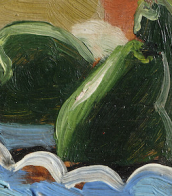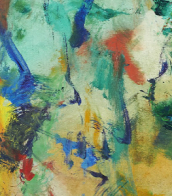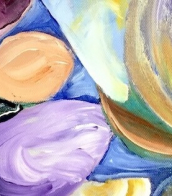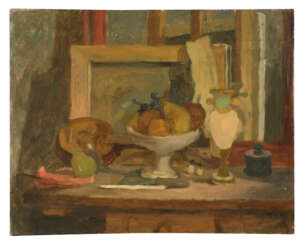afro

Afro Basaldella was an Italian abstractionist painter, a representative of lyrical abstraction, better known as Afro.
Afro's father and uncle were decorators, his two older brothers became sculptors, and to avoid confusion with surnames, the artist began signing his works with his first name only. Bazaldella trained in Florence, Venice and Rome. Shortly after graduation, his first monographic exhibition was held in Milan.
From 1935, Afro exhibited regularly at the Quadrennale in Rome and the Biennale in Venice. He made frescoes, notably for the Udine Opera House, and mosaics, and tried his hand at painting in a variety of directions. In 1941 he became a lecturer in mosaic painting at the Venice Academy of Fine Arts, and in 1950 he caused a sensation in the United States, and by the mid-1950s Afro's art was world famous.
Afro interpreted the Italian tradition in a modern abstract form that resulted from his painterly studies of color harmony.


Afro Basaldella was an Italian abstractionist painter, a representative of lyrical abstraction, better known as Afro.
Afro's father and uncle were decorators, his two older brothers became sculptors, and to avoid confusion with surnames, the artist began signing his works with his first name only. Bazaldella trained in Florence, Venice and Rome. Shortly after graduation, his first monographic exhibition was held in Milan.
From 1935, Afro exhibited regularly at the Quadrennale in Rome and the Biennale in Venice. He made frescoes, notably for the Udine Opera House, and mosaics, and tried his hand at painting in a variety of directions. In 1941 he became a lecturer in mosaic painting at the Venice Academy of Fine Arts, and in 1950 he caused a sensation in the United States, and by the mid-1950s Afro's art was world famous.
Afro interpreted the Italian tradition in a modern abstract form that resulted from his painterly studies of color harmony.


Afro Basaldella was an Italian abstractionist painter, a representative of lyrical abstraction, better known as Afro.
Afro's father and uncle were decorators, his two older brothers became sculptors, and to avoid confusion with surnames, the artist began signing his works with his first name only. Bazaldella trained in Florence, Venice and Rome. Shortly after graduation, his first monographic exhibition was held in Milan.
From 1935, Afro exhibited regularly at the Quadrennale in Rome and the Biennale in Venice. He made frescoes, notably for the Udine Opera House, and mosaics, and tried his hand at painting in a variety of directions. In 1941 he became a lecturer in mosaic painting at the Venice Academy of Fine Arts, and in 1950 he caused a sensation in the United States, and by the mid-1950s Afro's art was world famous.
Afro interpreted the Italian tradition in a modern abstract form that resulted from his painterly studies of color harmony.


Afro Basaldella was an Italian abstractionist painter, a representative of lyrical abstraction, better known as Afro.
Afro's father and uncle were decorators, his two older brothers became sculptors, and to avoid confusion with surnames, the artist began signing his works with his first name only. Bazaldella trained in Florence, Venice and Rome. Shortly after graduation, his first monographic exhibition was held in Milan.
From 1935, Afro exhibited regularly at the Quadrennale in Rome and the Biennale in Venice. He made frescoes, notably for the Udine Opera House, and mosaics, and tried his hand at painting in a variety of directions. In 1941 he became a lecturer in mosaic painting at the Venice Academy of Fine Arts, and in 1950 he caused a sensation in the United States, and by the mid-1950s Afro's art was world famous.
Afro interpreted the Italian tradition in a modern abstract form that resulted from his painterly studies of color harmony.


Afro Basaldella was an Italian abstractionist painter, a representative of lyrical abstraction, better known as Afro.
Afro's father and uncle were decorators, his two older brothers became sculptors, and to avoid confusion with surnames, the artist began signing his works with his first name only. Bazaldella trained in Florence, Venice and Rome. Shortly after graduation, his first monographic exhibition was held in Milan.
From 1935, Afro exhibited regularly at the Quadrennale in Rome and the Biennale in Venice. He made frescoes, notably for the Udine Opera House, and mosaics, and tried his hand at painting in a variety of directions. In 1941 he became a lecturer in mosaic painting at the Venice Academy of Fine Arts, and in 1950 he caused a sensation in the United States, and by the mid-1950s Afro's art was world famous.
Afro interpreted the Italian tradition in a modern abstract form that resulted from his painterly studies of color harmony.


Afro Basaldella was an Italian abstractionist painter, a representative of lyrical abstraction, better known as Afro.
Afro's father and uncle were decorators, his two older brothers became sculptors, and to avoid confusion with surnames, the artist began signing his works with his first name only. Bazaldella trained in Florence, Venice and Rome. Shortly after graduation, his first monographic exhibition was held in Milan.
From 1935, Afro exhibited regularly at the Quadrennale in Rome and the Biennale in Venice. He made frescoes, notably for the Udine Opera House, and mosaics, and tried his hand at painting in a variety of directions. In 1941 he became a lecturer in mosaic painting at the Venice Academy of Fine Arts, and in 1950 he caused a sensation in the United States, and by the mid-1950s Afro's art was world famous.
Afro interpreted the Italian tradition in a modern abstract form that resulted from his painterly studies of color harmony.


Afro Basaldella was an Italian abstractionist painter, a representative of lyrical abstraction, better known as Afro.
Afro's father and uncle were decorators, his two older brothers became sculptors, and to avoid confusion with surnames, the artist began signing his works with his first name only. Bazaldella trained in Florence, Venice and Rome. Shortly after graduation, his first monographic exhibition was held in Milan.
From 1935, Afro exhibited regularly at the Quadrennale in Rome and the Biennale in Venice. He made frescoes, notably for the Udine Opera House, and mosaics, and tried his hand at painting in a variety of directions. In 1941 he became a lecturer in mosaic painting at the Venice Academy of Fine Arts, and in 1950 he caused a sensation in the United States, and by the mid-1950s Afro's art was world famous.
Afro interpreted the Italian tradition in a modern abstract form that resulted from his painterly studies of color harmony.


Afro Basaldella was an Italian abstractionist painter, a representative of lyrical abstraction, better known as Afro.
Afro's father and uncle were decorators, his two older brothers became sculptors, and to avoid confusion with surnames, the artist began signing his works with his first name only. Bazaldella trained in Florence, Venice and Rome. Shortly after graduation, his first monographic exhibition was held in Milan.
From 1935, Afro exhibited regularly at the Quadrennale in Rome and the Biennale in Venice. He made frescoes, notably for the Udine Opera House, and mosaics, and tried his hand at painting in a variety of directions. In 1941 he became a lecturer in mosaic painting at the Venice Academy of Fine Arts, and in 1950 he caused a sensation in the United States, and by the mid-1950s Afro's art was world famous.
Afro interpreted the Italian tradition in a modern abstract form that resulted from his painterly studies of color harmony.


Afro Basaldella was an Italian abstractionist painter, a representative of lyrical abstraction, better known as Afro.
Afro's father and uncle were decorators, his two older brothers became sculptors, and to avoid confusion with surnames, the artist began signing his works with his first name only. Bazaldella trained in Florence, Venice and Rome. Shortly after graduation, his first monographic exhibition was held in Milan.
From 1935, Afro exhibited regularly at the Quadrennale in Rome and the Biennale in Venice. He made frescoes, notably for the Udine Opera House, and mosaics, and tried his hand at painting in a variety of directions. In 1941 he became a lecturer in mosaic painting at the Venice Academy of Fine Arts, and in 1950 he caused a sensation in the United States, and by the mid-1950s Afro's art was world famous.
Afro interpreted the Italian tradition in a modern abstract form that resulted from his painterly studies of color harmony.


Afro Basaldella was an Italian abstractionist painter, a representative of lyrical abstraction, better known as Afro.
Afro's father and uncle were decorators, his two older brothers became sculptors, and to avoid confusion with surnames, the artist began signing his works with his first name only. Bazaldella trained in Florence, Venice and Rome. Shortly after graduation, his first monographic exhibition was held in Milan.
From 1935, Afro exhibited regularly at the Quadrennale in Rome and the Biennale in Venice. He made frescoes, notably for the Udine Opera House, and mosaics, and tried his hand at painting in a variety of directions. In 1941 he became a lecturer in mosaic painting at the Venice Academy of Fine Arts, and in 1950 he caused a sensation in the United States, and by the mid-1950s Afro's art was world famous.
Afro interpreted the Italian tradition in a modern abstract form that resulted from his painterly studies of color harmony.


Afro Basaldella was an Italian abstractionist painter, a representative of lyrical abstraction, better known as Afro.
Afro's father and uncle were decorators, his two older brothers became sculptors, and to avoid confusion with surnames, the artist began signing his works with his first name only. Bazaldella trained in Florence, Venice and Rome. Shortly after graduation, his first monographic exhibition was held in Milan.
From 1935, Afro exhibited regularly at the Quadrennale in Rome and the Biennale in Venice. He made frescoes, notably for the Udine Opera House, and mosaics, and tried his hand at painting in a variety of directions. In 1941 he became a lecturer in mosaic painting at the Venice Academy of Fine Arts, and in 1950 he caused a sensation in the United States, and by the mid-1950s Afro's art was world famous.
Afro interpreted the Italian tradition in a modern abstract form that resulted from his painterly studies of color harmony.


Afro Basaldella was an Italian abstractionist painter, a representative of lyrical abstraction, better known as Afro.
Afro's father and uncle were decorators, his two older brothers became sculptors, and to avoid confusion with surnames, the artist began signing his works with his first name only. Bazaldella trained in Florence, Venice and Rome. Shortly after graduation, his first monographic exhibition was held in Milan.
From 1935, Afro exhibited regularly at the Quadrennale in Rome and the Biennale in Venice. He made frescoes, notably for the Udine Opera House, and mosaics, and tried his hand at painting in a variety of directions. In 1941 he became a lecturer in mosaic painting at the Venice Academy of Fine Arts, and in 1950 he caused a sensation in the United States, and by the mid-1950s Afro's art was world famous.
Afro interpreted the Italian tradition in a modern abstract form that resulted from his painterly studies of color harmony.


Afro Basaldella was an Italian abstractionist painter, a representative of lyrical abstraction, better known as Afro.
Afro's father and uncle were decorators, his two older brothers became sculptors, and to avoid confusion with surnames, the artist began signing his works with his first name only. Bazaldella trained in Florence, Venice and Rome. Shortly after graduation, his first monographic exhibition was held in Milan.
From 1935, Afro exhibited regularly at the Quadrennale in Rome and the Biennale in Venice. He made frescoes, notably for the Udine Opera House, and mosaics, and tried his hand at painting in a variety of directions. In 1941 he became a lecturer in mosaic painting at the Venice Academy of Fine Arts, and in 1950 he caused a sensation in the United States, and by the mid-1950s Afro's art was world famous.
Afro interpreted the Italian tradition in a modern abstract form that resulted from his painterly studies of color harmony.


Afro Basaldella was an Italian abstractionist painter, a representative of lyrical abstraction, better known as Afro.
Afro's father and uncle were decorators, his two older brothers became sculptors, and to avoid confusion with surnames, the artist began signing his works with his first name only. Bazaldella trained in Florence, Venice and Rome. Shortly after graduation, his first monographic exhibition was held in Milan.
From 1935, Afro exhibited regularly at the Quadrennale in Rome and the Biennale in Venice. He made frescoes, notably for the Udine Opera House, and mosaics, and tried his hand at painting in a variety of directions. In 1941 he became a lecturer in mosaic painting at the Venice Academy of Fine Arts, and in 1950 he caused a sensation in the United States, and by the mid-1950s Afro's art was world famous.
Afro interpreted the Italian tradition in a modern abstract form that resulted from his painterly studies of color harmony.









































































